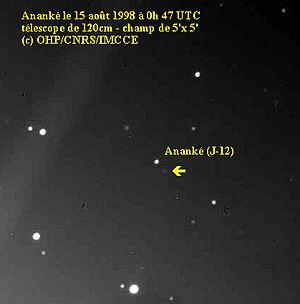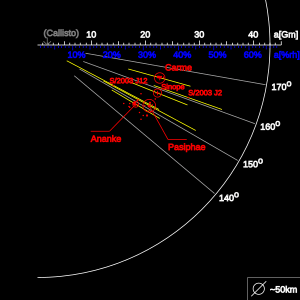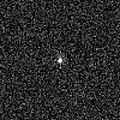Ananke (moon) facts for kids
| Discovery | |
|---|---|
| Discovered by | S. B. Nicholson |
| Discovery date | September 28, 1951 |
| Orbital characteristics | |
| Periapsis | 12,567,000 km |
| Apoapsis | 29,063,500 km |
|
Mean orbit radius
|
21,280,000 km |
| Eccentricity | 0.24 |
| 610.45 d (1.680 a) | |
|
Average orbital speed
|
2.367 km/s |
| Inclination | 148.89° (to the ecliptic) 149.9° (to Jupiter's equator) |
| Satellite of | Jupiter |
| Physical characteristics | |
|
Mean radius
|
14 km |
| ~2500 km2 | |
| Volume | ~11,500 km3 |
| Mass | 4.0×1016 kg |
|
Mean density
|
2.6 g/cm3 (assumed) |
| 0.010 m/s2 (0.001 g) | |
| ~0.017 km/s | |
| Albedo | 0.04 (assumed) |
| Temperature | ~124 K |
Ananke is a moon that orbits the planet Jupiter. It is known as a retrograde moon because it orbits Jupiter in the opposite direction to Jupiter's rotation. Ananke is also not perfectly round, meaning it is a non-spherical moon.
Seth Barnes Nicholson discovered Ananke at Mount Wilson Observatory in 1951. It is named after Ananke, a goddess from Greek mythology. She was said to be the mother of Adrastea by Jupiter. When we talk about things related to Ananke, we use the word Anankean.
Ananke did not get its current name until 1975. Before that, it was simply called Jupiter XII. For a while, between 1955 and 1975, some people called it "Adrastea". It's important to know that Adrastea is now the name of a different moon of Jupiter.
Ananke gives its name to the Ananke group of moons. These are a family of moons that orbit Jupiter in a similar way. They are all retrograde and not perfectly round. They orbit Jupiter at distances between 19,300,000 and 22,700,000 kilometers. Their orbits are also tilted at an angle of about 150 degrees.
Ananke's Orbit Around Jupiter
Ananke travels around Jupiter in a very unique way. Its orbit is not a perfect circle; it has a high eccentricity, meaning it's quite stretched out. It also has a high inclination, which means its orbit is very tilted compared to Jupiter's equator. As mentioned, it moves in a retrograde direction, which is backwards compared to most moons.
Since the year 2000, scientists have found eight other moons that are not round and follow similar paths around Jupiter. Ananke's orbital path changes over time because of the strong pull from the Sun and other planets.
The picture on the left shows Ananke's orbit along with other irregular moons that orbit Jupiter backwards. The yellow lines show how stretched out some of these orbits are. For comparison, Callisto, one of Jupiter's largest and most distant round moons, is also shown.
Scientists believe that Ananke is the biggest piece left over from a larger object that broke apart a long time ago. This event likely formed the entire Ananke group of moons.
What Ananke Looks Like
When we look at Ananke with regular light, it appears to be grey or light-red in color.
Using special equipment that sees infrared light, Ananke seems similar to P-type asteroids. There might even be signs of water on its surface.
Images for kids
See also
 In Spanish: Ananké (satélite) para niños
In Spanish: Ananké (satélite) para niños




